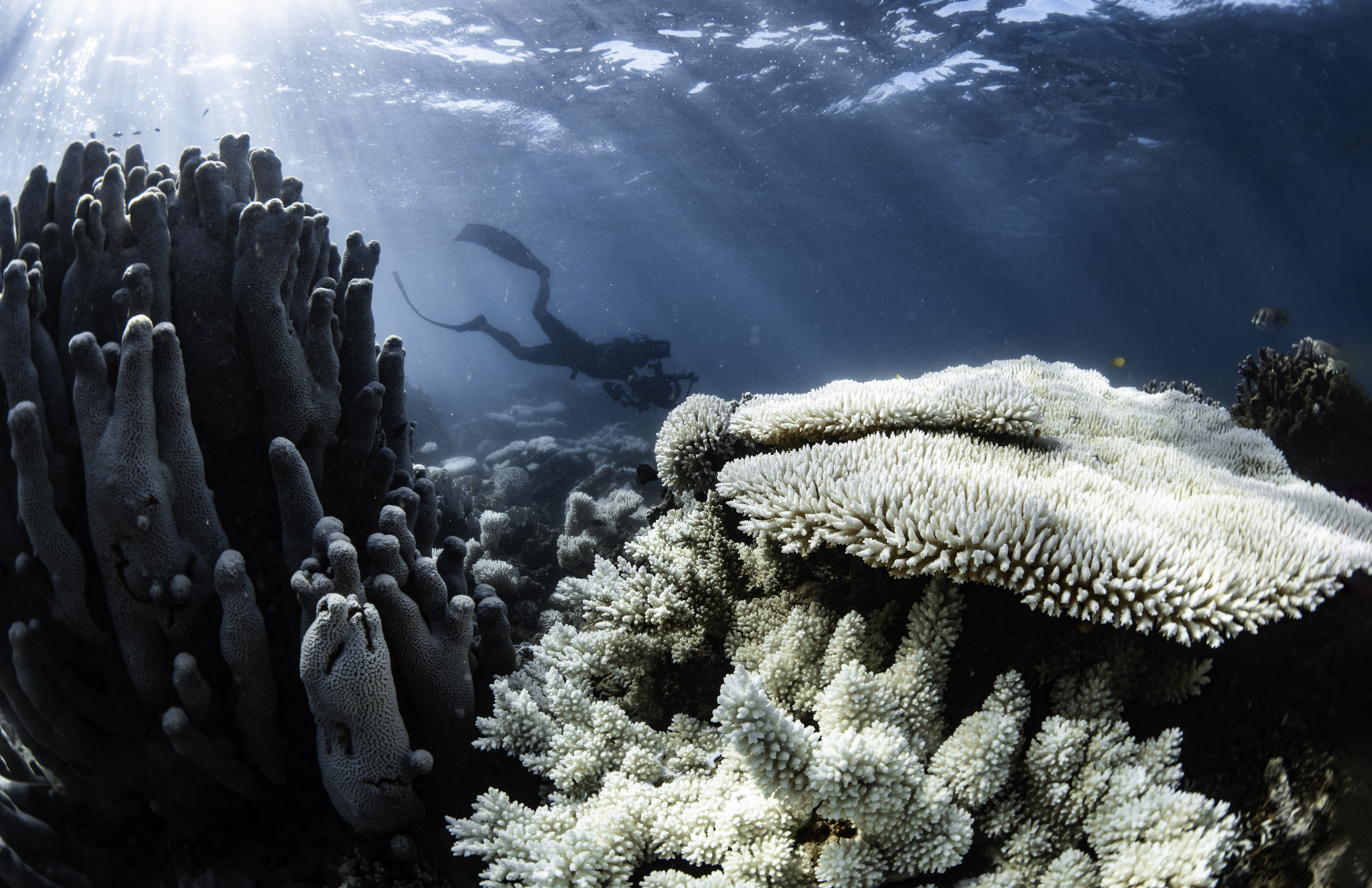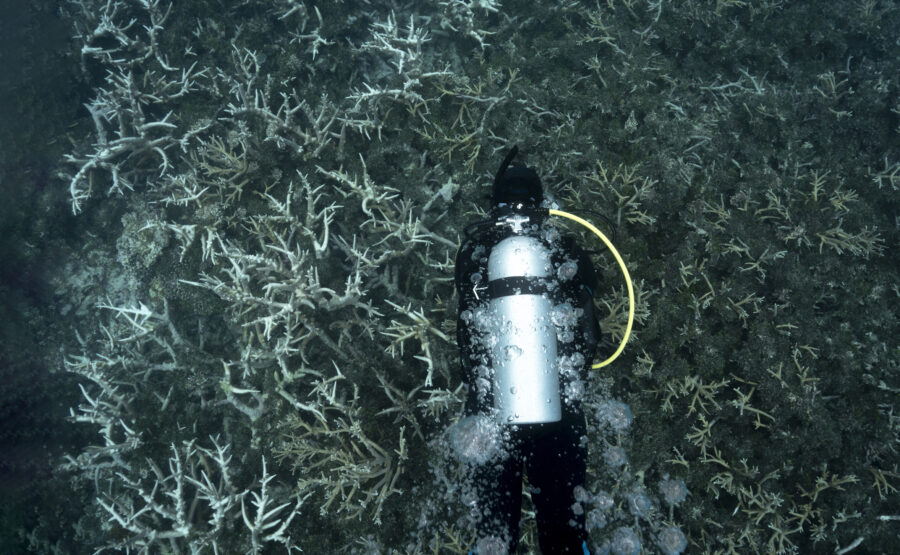We’ve become all too familiar with mass coral bleaching events in the Great Barrier Reef along Australia’s east coast, but the continent’s other great coral reef, Western Australia’s Ningaloo, has been mostly spared. Until now.
For many West Aussies – me included – Ningaloo Reef is a cherished part of their identity. Aside from being famous for whale sharks, the reef is part of the Baiyungu, Yinigurdira and Thalanyji peoples’ traditional land and sea country, and also features on the UNESCO World Heritage List.
For Exmouth resident Brooke Pyke, Ningaloo is a passion. Brooke works as a whale shark tour photographer, and in her spare time she freedives with her camera. In February, Brooke took to social media to document an unfolding disaster: the mass bleaching of Ningaloo.
“I knew that if I could share photos, it would hopefully get into the forefront of everyone’s minds, and especially get into the news with our upcoming election at the time,” Brooke says.
Brooke’s images had their intended effect and shocked the public. Seeing the photos felt like a punch in the stomach; coral colonies large and small were ghostly white, while others were fluorescing bright colours in their dying days.
Brooke returns to her favourite corals almost daily, and as she explains the progression, she chokes back tears.
“Corals that were still alive, but in a stressed, bleached state, they’re now covered in algae and have already perished, including some of the huge Porites corals that we have here,” she says. “It’s like losing your best friend, really.”
Looking for solutions
Ningaloo Reef has not suffered a significant bleaching since 2011–13. When compared with the Great Barrier Reef, there are a number of threats that aren’t present in WA. These include major rivers that transport pollutants, population pressures, and plagues of the coral-eating crown-of-thorns starfish (Acanthaster planci).
But overwhelmingly, climate change is the main threat to coral reefs worldwide, specifically marine heatwaves – and Ningaloo certainly isn’t immune to those. Rising ocean temperatures cause coral bleaching and, in severe cases, coral death.
Many research groups study Ningaloo and WA’s other coral reefs, including CSIRO, the Australian Institute of Marine Science (AIMS), the WA Department of Biodiversity, Conservation and Attractions (DBCA), and several universities. They collaborate to form the WA Coral Bleaching Group, sharing knowledge and resources.
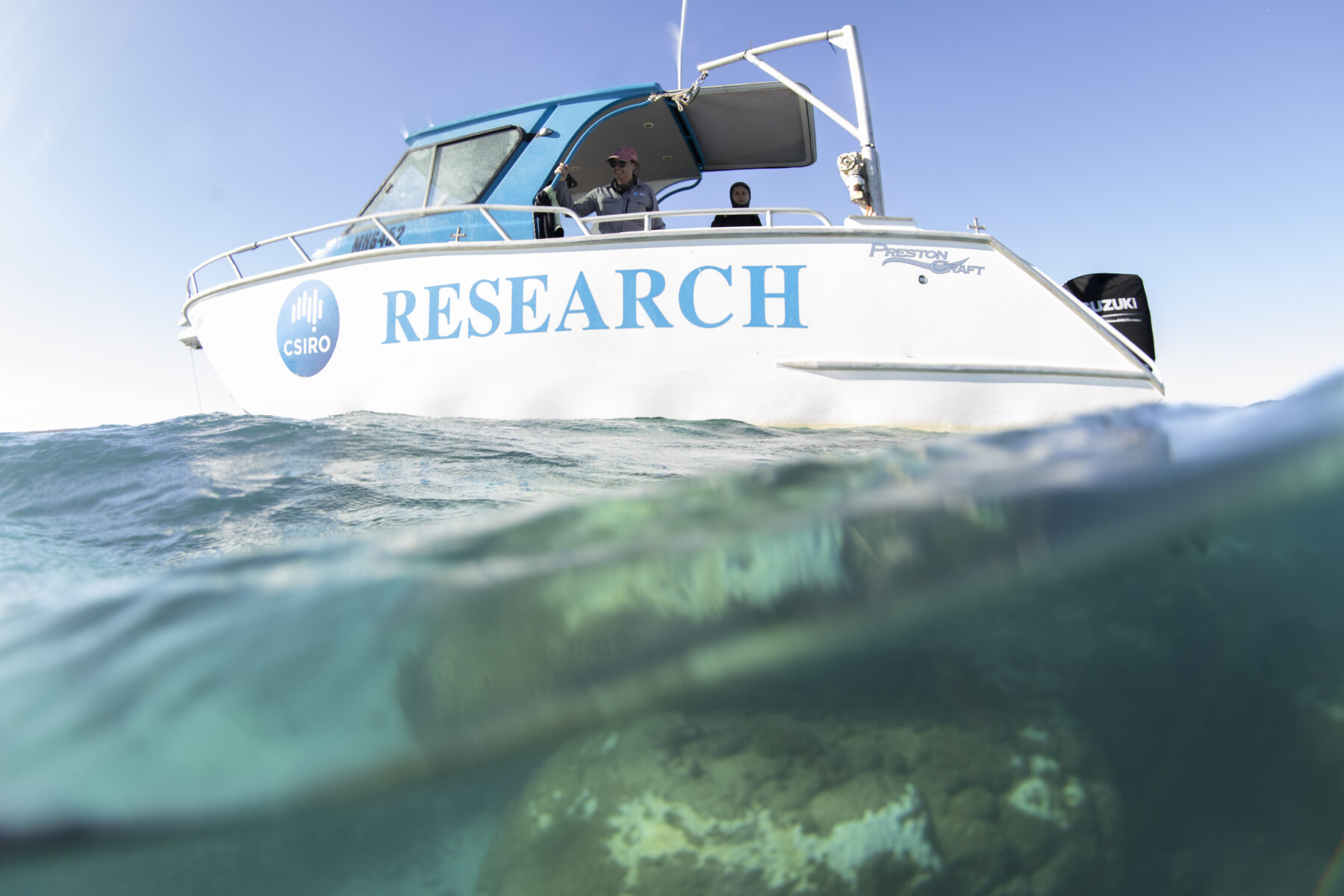
Dr Damian Thomson is a marine ecologist for CSIRO, and the leader of a long-term ecological study named Ningaloo Outlook. When I speak to Damian, he’s at Ningaloo conducting reef surveys of 80 sites between one and 15 metres deep. Damian has surveyed these sites since 2007, and more intensely since 2015.
“All of the sites have quite extensive coral bleaching, so the event is still very much underway,” Damian says. “We’re seeing around 60 to 90 per cent of the corals at each location have remained heavily bleached, and within that group probably 30 per cent have started to die.”
The extent of the coral mortality will be quantified in a few months. Some corals may still recover, but Damian suspects many will die because of the intensity and duration of the bleaching event.
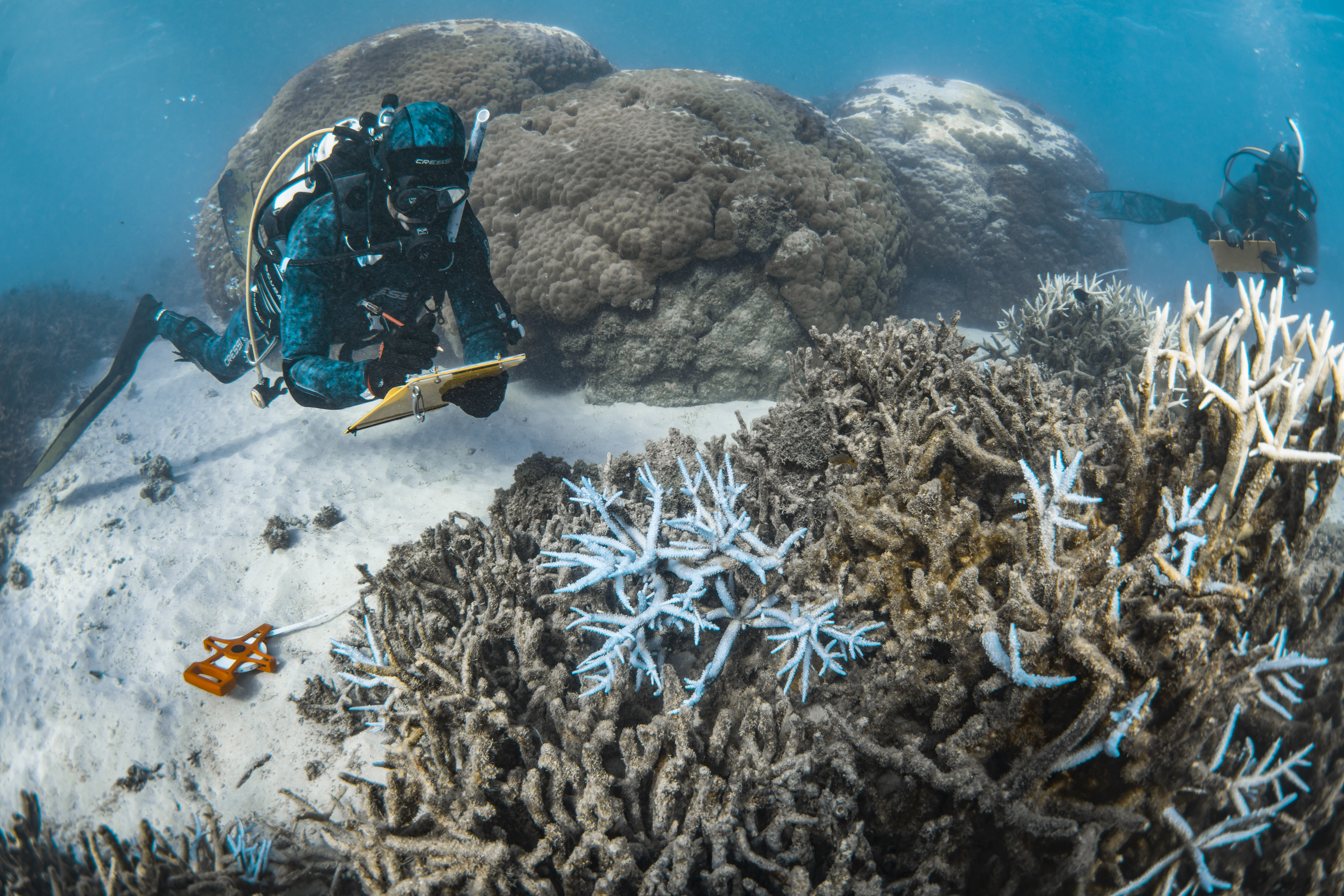
Ningaloo’s previous bleaching event mostly affected branching corals inside the shallow lagoon. But this event sees severe bleaching all the way down to 20m, which has never been witnessed before. Like Brooke, Damian is shocked about the bleaching of Porites corals, which were generally considered less susceptible.
“That’s indicative of the intensity of this event, because some of those massive corals would be over 500 years old,” Damian says. Even tiny juvenile corals are bleaching this time. If they die too, recovery will be even slower.
Damian says his team only found one area where the damage was slightly less. “In the very north of our survey area, those sites are quite turbid,” he explains, referring to suspended sediment in the water that may have reduced the overall stress. “The level of bleaching there is maybe about 10 or 20 per cent less than other sites.”
It’s not much of a positive, and this year’s survey is taking an emotional toll.
“For the first time ever at Ningaloo, I’m questioning the long-term viability of the reef,” Damian says. “A couple of [people in] the team have quite young children, and they were lamenting the fact that their kids will probably never see Ningaloo in the same state that we have.”
The reality of warming
While Ningaloo may be WA’s tourism poster child, coral reefs also flank the Pilbara and the Kimberley, as well as occurring hundreds of kilometres offshore at the Rowley Shoals, plus the Scott and Ashmore reefs.
Dr James Gilmour is a reef ecologist with AIMS. He explains that northern oceanic reefs such as Scott and Ashmore have previously bleached due to extreme heat from El Niño events. Conversely, Ningaloo Reef further south has been affected by La Niña events.
But in the past five years or so, background temperatures in the ocean have increased, and bleaching is no longer limited to those extreme events.
Normally, sea temperatures in north-western Australia peak in October and November and are then cooled by the cloud cover of the monsoon in about December. Temperatures normally rise again from February to April. This year, the monsoon only arrived in mid-February, meaning that corals were already bleaching by the end of 2024, with no respite over several months.
Temperatures recorded at Ningaloo, the Pilbara, the Rowley Shoals and the northern inshore Kimberley were by far the highest on record. “It’s the first time we’ve seen this – a single event that has affected all of the coral reefs in WA,” James says.
James and his team have just returned from the Rowley Shoals, about 300km west of Broome. Along with the inshore Kimberley reefs, this system has never severely bleached. James says both reef systems have been located in a ‘lucky’ geographic position, avoiding the worst of the El Niño and La Niña events – until now.
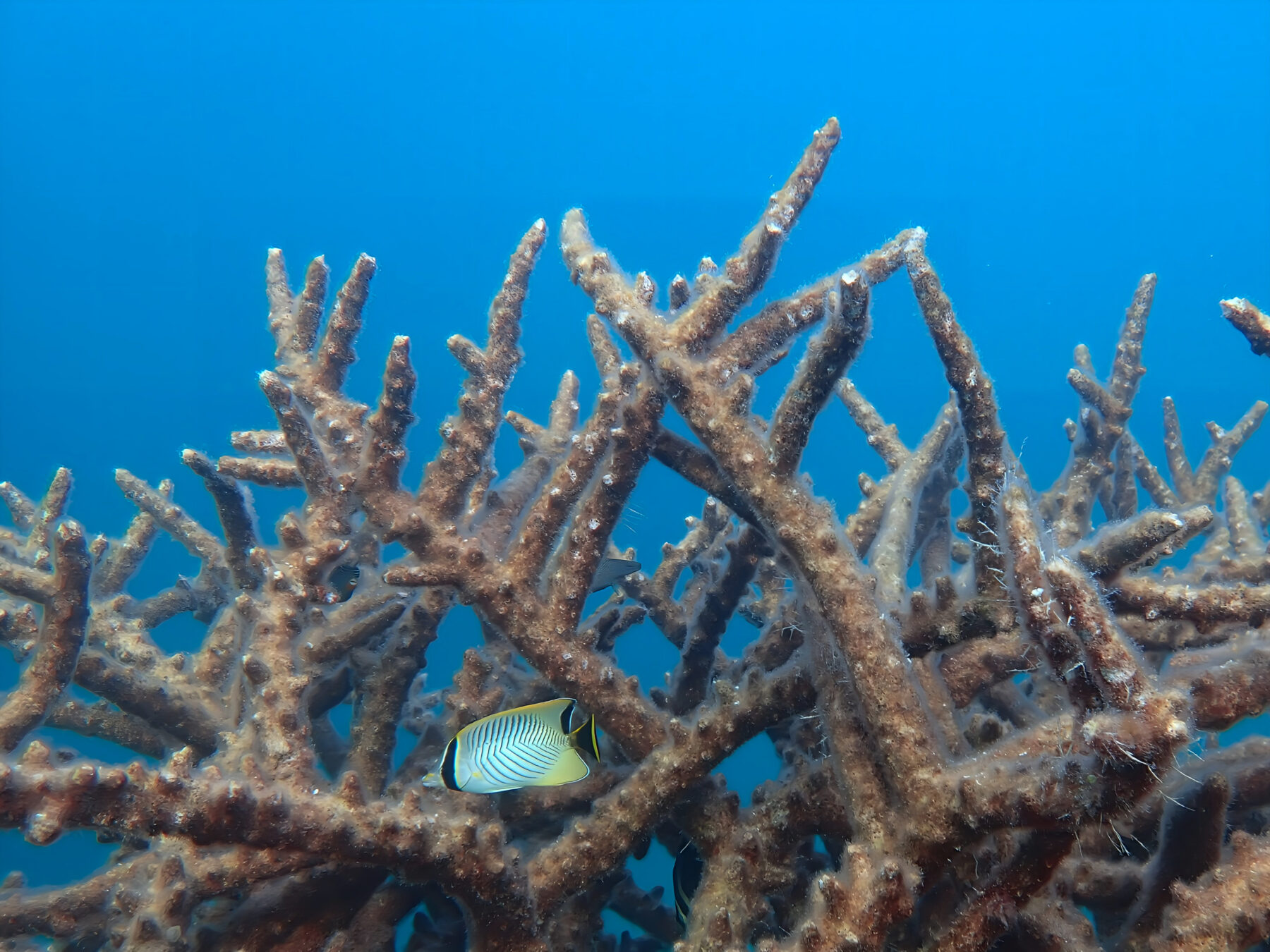
What James describes next causes me physical pain. Just a few years ago, I dived at the Rowley Shoals. It was a heaving mass of unfathomable biodiversity, from vibrant coral gardens to magnificent sailfish.
“This time, we saw mass bleaching of the Rowley Shoals and evidence of mortality,” James says. Well over three quarters of the corals surveyed at the Rowley Shoals are bleached and/or dying.
For James, who has spent his whole career studying coral reefs, this is devastating.
“I was always heartened by the fact that WA reefs were far healthier than most around the world, and that there were still these places that hadn’t bleached badly,” he says. “But we have, as of right now, reached that point where they are also severely affected.”
Given time, these reefs can regenerate. Scott Reef lost about 80 per cent of its corals in 1998 and within 10–15 years it had largely recovered.
“We do know that nature is really resilient,” James says. “But there are only so many bleaching events that nature can withstand.”
He says if bleaching occurs repeatedly in a five-year period, the system will quickly degrade. We’re not likely to lose all corals, because some species are less susceptible to bleaching than others. Some small adaptations to heat are happening, although not quickly enough.
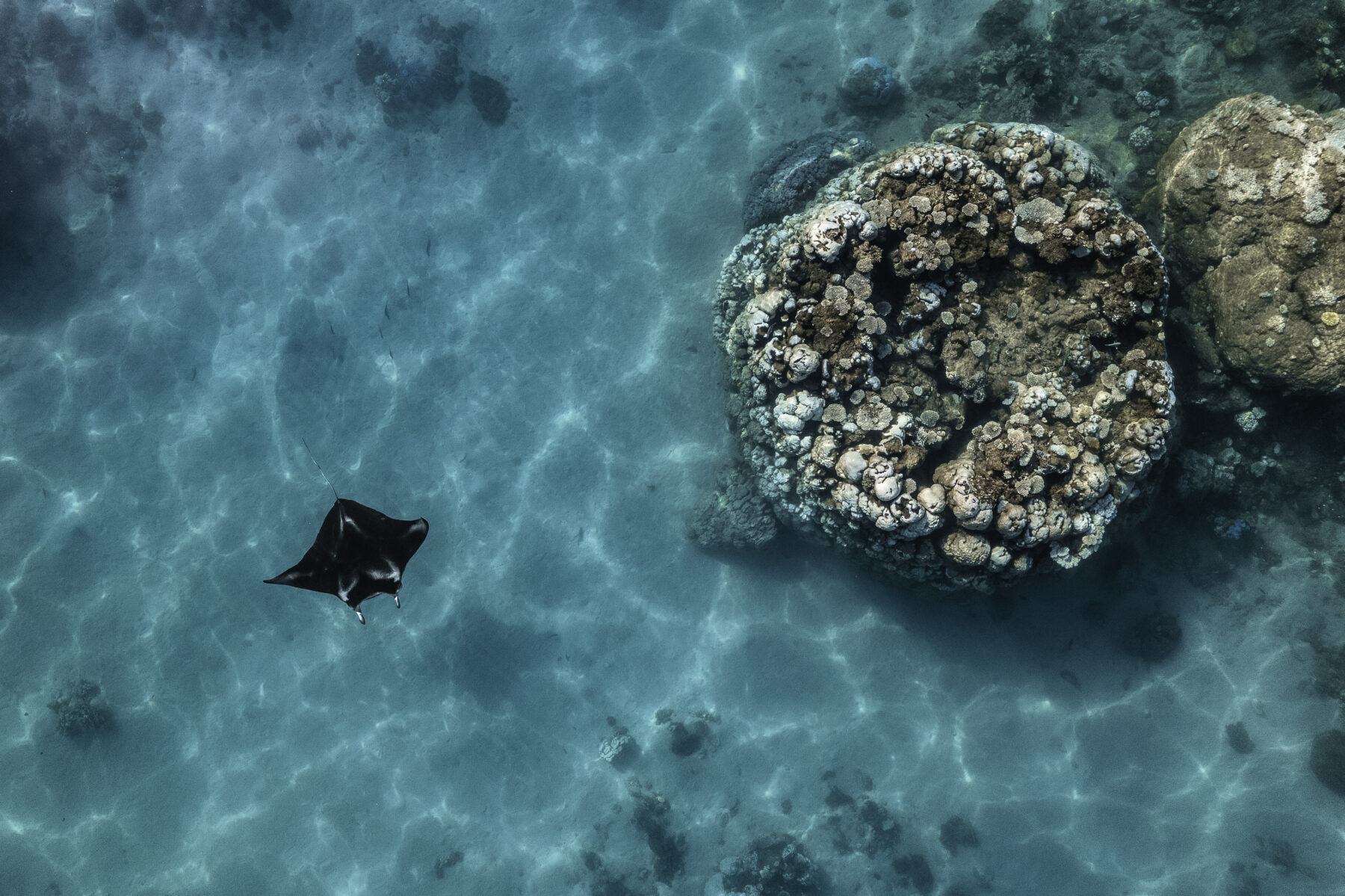
Many of the corals most susceptible to bleaching and other disturbances are branching corals. These are also the corals providing reef structure, habitat and food for many fish. If these die, there will be obvious implications for tourism, fisheries and other related industries.
“There’s no way that we’ll be able to retain coral reefs as we know them in coming decades,” James says.
The task now for scientists is to investigate management techniques that are useful in protecting these modified future reefs.
“The fundamental cause, without a doubt, is carbon emissions and climate change globally,” James says. “So that’s the first and primary thing that we always talk about having to address.”
Secondly, traditional management techniques may be useful. That includes reducing pollution, controlling fishing pressure, and controlling any predators such as crown-of-thorns starfish. In the WA context, most of these are already well-managed.
And thirdly, science can examine novel interventions to help reefs by producing corals that can survive warming oceans. James notes this is a significant challenge, because solutions must be scalable.
Most of the intervention studies are happening in Queensland, from trying to cool the reef through enhanced cloud cover to finding heat-tolerant coral species and assisting recolonisation with live coral larvae. Some of the trials sound like science fiction, but everything is worth considering.
James says modelling our current trajectory is vitally important.
“We’ve passed the point of having extensive, pristine, highly biodiverse environments, at least for a few hundred years,” James says. “That’s the trajectory we’re on. But being able to nudge it in a slightly different direction, to where it’s still a benefit to humanity, is really what we’re talking about.”
Wider impacts
Aside from affecting coral reefs, marine heatwaves have other, less obvious impacts. The Leeuwin Current, which flows north to south along the WA coastline, may bring the occasional manta ray south – to the delight of Perth swimmers. But this warm water can also devastate ecosystems.
DBCA conducts monitoring inside WA’s marine parks, including Shark Bay. In the 2011 heatwave, Shark Bay lost about 1300sq.km of seagrasses, which underpin the ecosystem and are a significant carbon sink.
According to Dr Thomas Holmes, DBCA marine science program leader, other notable occurrences included significant loss of kelps between Kalbarri and Jurien Bay, and a decline in coastal whitebait in the Perth area.
It’s too soon to know how the 2024–25 heatwave affected Shark Bay’s seagrasses, but DBCA plans to monitor for changes over the next 12 months.
Warmer temperatures can also play havoc with commercial fisheries. Dr Simon de Lestang is the principal research scientist for WA’s Department of Primary Industries and Regional Development. He says that during the 2011 heatwave some fisheries stocks were impacted almost immediately, including redthroat emperor (Lethrinus miniatus) and Spanish mackerel (Scomberomorus commerson), both of which moved south. Other impacts were delayed.
“We didn’t see too much happening initially, but about a month later, all the abalone were dead along the reef platforms around Greenough,” he says.
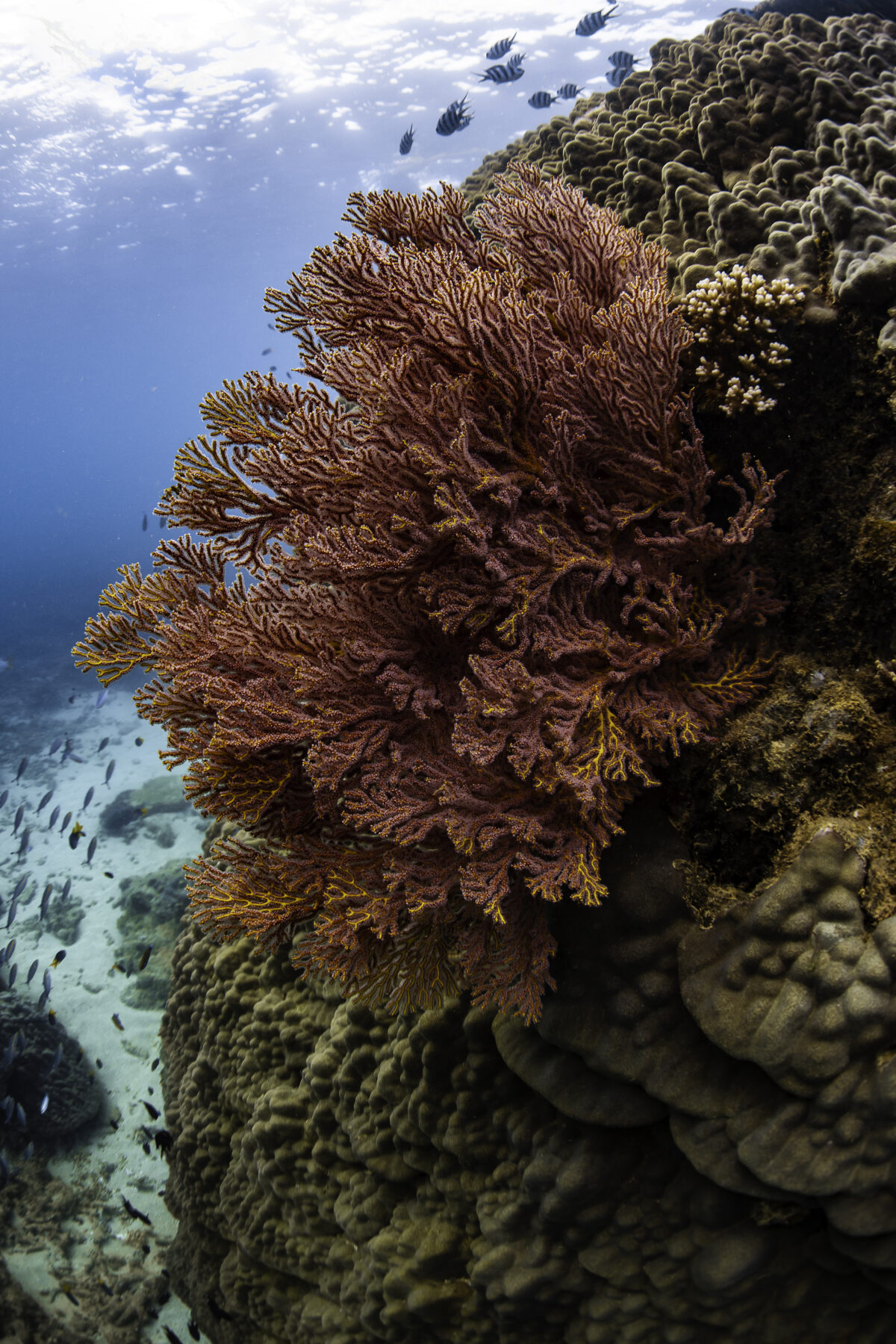
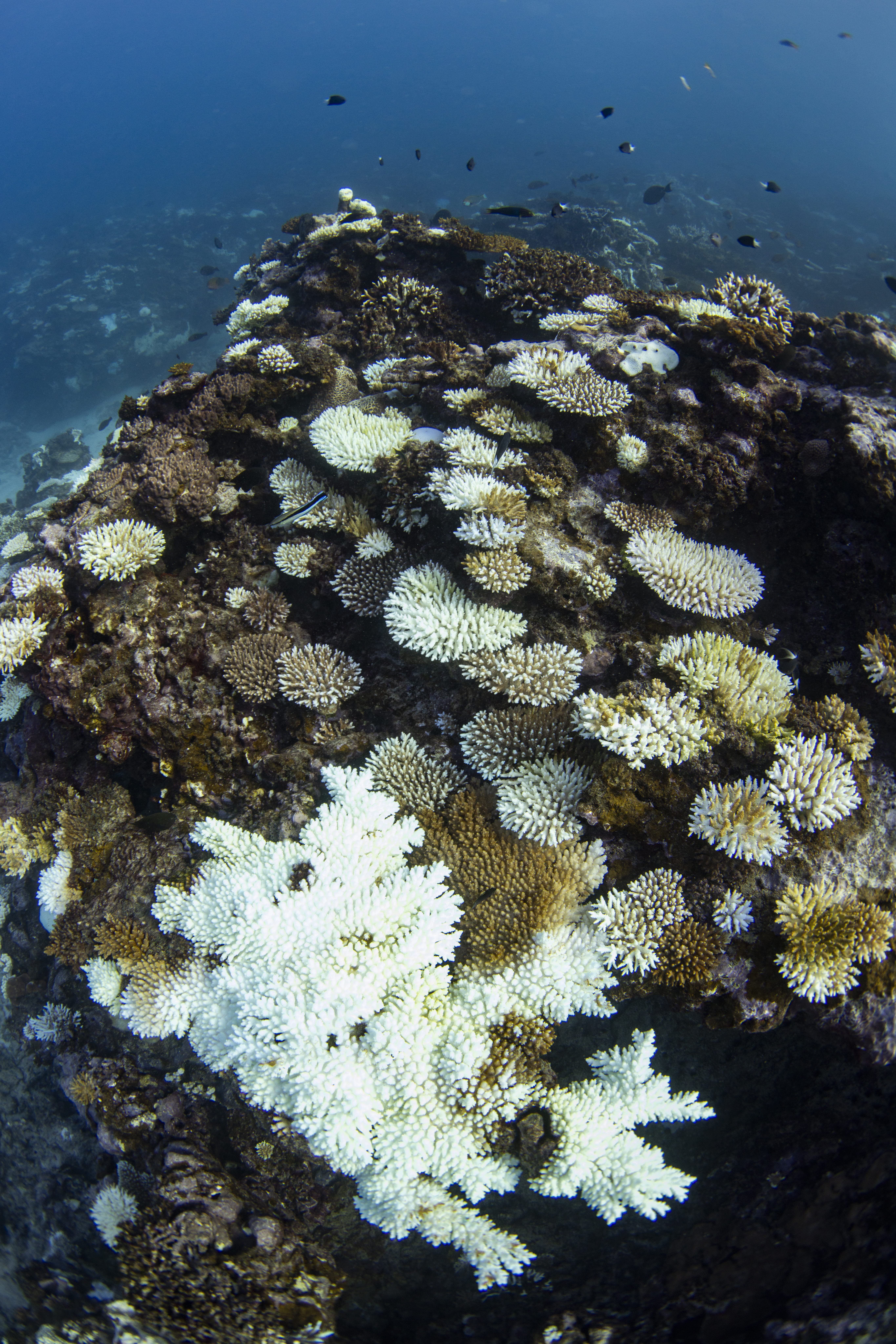
For the valuable Western Rock Lobster fishery along WA’s coast, there was also a lag in the effects. Usually, counts of juvenile lobsters, called Puerulus, inform predicted catch rates approximately four years in advance. But after the heatwave, this indicative measure became less accurate.
In the northern part of the fishery, where the temperature was most elevated, fewer adult lobsters were turning up than would be expected. Further south, more adult lobsters were caught than predicted.
Simon says this is likely to do with the altered abundance of food for juveniles, such as marine snails, similar to the abalone.
Heatwaves also affect fisheries through range extensions, where species turn up in unusual places.
“A few mud crabs were being caught in Augusta [in south-west WA] when they’d normally be found in Exmouth Gulf,” Simon says. “Large numbers of blue swimmer crabs (Portunus pelagicus) turned up in south-coast estuaries, and commercial fishers were able to benefit from that.”
For all of these scientists, marine heatwaves are becoming an increasingly distressing part of their work. In isolation, the degradation of any of these environments is devastating. But viewed collectively, the loss of them all is frightening.
James says he hopes people realise that the loss of coral reefs is about more than just the loss of beauty and wonder.
“We’ve gone past the point of being sad about losing the most pristine, most beautiful parts of the world, into now starting to lose the natural resources on which we depend as humans,” he says. “I hope this is the wake-up call and we all begin to realise that these things are a priority for existence.”
As we non-scientists grapple with the implications of marine heatwaves, James urges us to get out and appreciate our reefs, which are still some of the best in the world.
“Then just talk to everyone about it,” James says. “Get the word out.” That, he says, will promote appreciation of the reefs – both their value, and their beauty – and make Australians aware of the stark threats they face.
